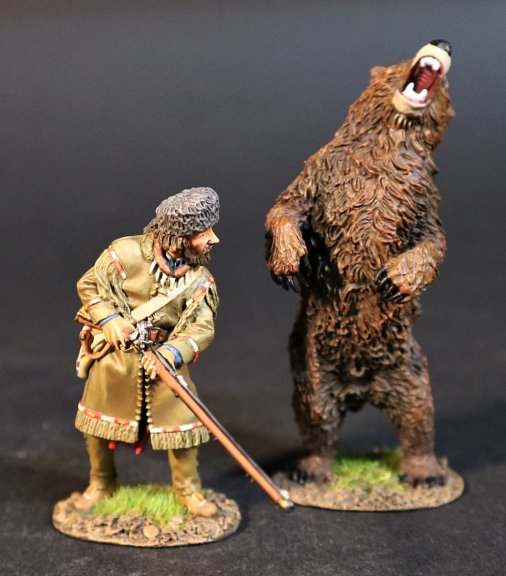- Joined
- Feb 2, 2011
- Messages
- 2,093
NEW RELEASES FOR NOVEMBER 2022
THE FUR TRADE
MOUNTAIN MEN
A mountain man was an explorer who lived in the wilderness. They were instrumental in opening up the various Emigrant Trails (widened into wagon roads) allowing Americans in the east to settle the new territories of the far west by organized wagon trains traveling over roads explored and in many cases, physically improved by the mountain men and the big fur companies originally to serve the mule train based inland fur trade.
Mountain men were most common in the North American Rocky Mountains from about 1810 through to the 1880s (with a peak population in the early 1840s). Approximately 3,000 mountain men ranged the mountains between 1820 and 1840, the peak beaver-harvesting period. While there were many free trappers, most mountain men were employed by major fur companies. The life of a company man was almost militarized. The men had mess groups, hunted and trapped in brigades and always reported to the head of the trapping party.
This man was called a "boosway", a bastardization of the French term bourgeois. He was the leader of the brigade and the head trader.
The Mountain men represents the “Beaver Pelts” of the original WSP title, and is the smallest part of the series, as it mainly concentrates on the individual men and personalities that worked alone or in pairs in the mountain wilderness.

WSP-26
THE FUR TRADE,
MOUNTAIN MEN,
HUGH GLASS AND A GRIZZLY BEAR.
(2 pcs)
Hugh Glass (C. 1783 – 1833) was an American frontiersman, fur trapper, trader, hunter and explorer. He is best known for his story of survival and forgiveness after being left for dead by companions when he was mauled by a grizzly bear.
No records exist regarding his origins but he is widely said to have been born in Pennsylvania to Scots and Irish parents. Glass became an explorer of the Upper Missouri River, in present day Montana, the Dakotas, and the Platte River area of Nebraska.
His life story has been the basis of two feature films, most recently the 2015 “The Revenant”.
Both films portray the survival struggle of Glass, who crawled and stumbled 200 miles to Fort Kiowa, South Dakota, after being abandoned without supplies or weapons by fellow explorers and fur traders during General Ashley’s expedition of 1823.
** PLEASE CONTACT YOUR LOCAL DEALER FOR FURTHER INFORMATION **
THE FUR TRADE
MOUNTAIN MEN
A mountain man was an explorer who lived in the wilderness. They were instrumental in opening up the various Emigrant Trails (widened into wagon roads) allowing Americans in the east to settle the new territories of the far west by organized wagon trains traveling over roads explored and in many cases, physically improved by the mountain men and the big fur companies originally to serve the mule train based inland fur trade.
Mountain men were most common in the North American Rocky Mountains from about 1810 through to the 1880s (with a peak population in the early 1840s). Approximately 3,000 mountain men ranged the mountains between 1820 and 1840, the peak beaver-harvesting period. While there were many free trappers, most mountain men were employed by major fur companies. The life of a company man was almost militarized. The men had mess groups, hunted and trapped in brigades and always reported to the head of the trapping party.
This man was called a "boosway", a bastardization of the French term bourgeois. He was the leader of the brigade and the head trader.
The Mountain men represents the “Beaver Pelts” of the original WSP title, and is the smallest part of the series, as it mainly concentrates on the individual men and personalities that worked alone or in pairs in the mountain wilderness.

WSP-26
THE FUR TRADE,
MOUNTAIN MEN,
HUGH GLASS AND A GRIZZLY BEAR.
(2 pcs)
Hugh Glass (C. 1783 – 1833) was an American frontiersman, fur trapper, trader, hunter and explorer. He is best known for his story of survival and forgiveness after being left for dead by companions when he was mauled by a grizzly bear.
No records exist regarding his origins but he is widely said to have been born in Pennsylvania to Scots and Irish parents. Glass became an explorer of the Upper Missouri River, in present day Montana, the Dakotas, and the Platte River area of Nebraska.
His life story has been the basis of two feature films, most recently the 2015 “The Revenant”.
Both films portray the survival struggle of Glass, who crawled and stumbled 200 miles to Fort Kiowa, South Dakota, after being abandoned without supplies or weapons by fellow explorers and fur traders during General Ashley’s expedition of 1823.
** PLEASE CONTACT YOUR LOCAL DEALER FOR FURTHER INFORMATION **


